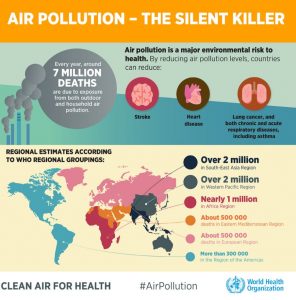The World Health Organization has included air pollution among the top ten threats to public health in 2019.
What is Air pollution?
Air pollution can be defined as the process of various pollutants being dispersed into the air which lead to harmful effects on all living organisms and the environment.1 Pollutants include ozone, carbon dioxide and other noxious gases and particulate matter. There is a growing amount of evidence that airborne particulate matter causes several adverse health effects and leads to disease and even death.
Particulate Matter
- Particulate matter is a mixture of solid and liquid particles, of different sizes and various chemical constituents that are suspended in the atmospheric air.
- Chemicals can include nitrates, sulfates, elemental and organic carbon, organic compounds, biological compounds (e.g., endotoxin, cell fragments) and metals
- PM can be produced in indoor and outdoor environments. For example, tobacco smoke is a common source of indoor particulate matter pollution
- The two main types include fine (PM1.0, smaller than 1.0 μm in size) and ultrafine (PM2.5, PM smaller than 2.5 μm in size) particles.
- Due to their small size, the inhaled particles are able to pass through the lungs (alveoli) directly into the blood circulation, ultimately affecting multiple organs.
- PM causes acute and chronic health effects on cardiovascular and respiratory systems, in addition to having an association with cancer, diabetes and increased morbidity and mortality.1
- Children in particular, are more susceptible to stunted brain development, reduced lung function and asthma exacerbations due to their small body size and developing organs.
As specified by the World Health Organization, there is no evidence of a safe limit of PM exposure making it of utmost importance to reducing production and exposure to air pollution.
Sources of air pollution are mostly caused by human activities, including:2
- Agriculture
- Household
- Industry
- Transport
- Waste
- Other sources
Some measures that can reduce Air Pollution
| Problem | Measure |
| Burning fossil fuels | “Use renewable and clean energy solutions at home and in the industry. |
| A source of household PM can be from cooking with wood stoves, burning candles or fireplaces | “Avoid using candles and keep use of fireplaces to a minimum. |
| The global transport sector accounts for almost one-quarter of energy-related carbon dioxide emissions | “Take public transport or carpool to reduce air pollution. |
| A big issue in Europe is the pollution made on our beaches.According to the European Environment Agency (EEA), the most commonly littered items are plastics and cigarette butts3
The majority of marine litter comes from land-based sources4 |
“Pick up after yourself on the beach, and make sure to properly dispose of cigarette buttsor even better,
use it as another reason to quit smoking! |
| Agriculture is responsible for a great amount of greenhouse emissions. | “Farmers can improve grazing and grassland management for their livestock.“In addition, reduction of red meat consumption and increase of plant-based foods. |
References
- Kim K, Kabir E, Kabir S. A review on the human health impact of airborne particulate matter. Environ Int. 2015;74:136-143. doi:10.1016/j.envint.2014.10.005
- United Nations Environment. World Environment Day 2019 | UN Environment. https://www.unenvironment.org/events/un-environment-event/world-environment-day-2019. Accessed June 4, 2019.
- European Environment Agency. New data collected by citizens: Cigarette butts and filters the most common pieces of litter on Europe’s beaches. https://www.eea.europa.eu/highlights/new-data-collected-by-citizens. Published 2018.
- Munari C, Corbau C, Simeoni U, Mistri M. Marine litter on Mediterranean shores: Analysis of composition, spatial distribution and sources in north-western Adriatic beaches. Waste Manag. 2016;49:483-490. doi:10.1016/J.WASMAN.2015.12.010

